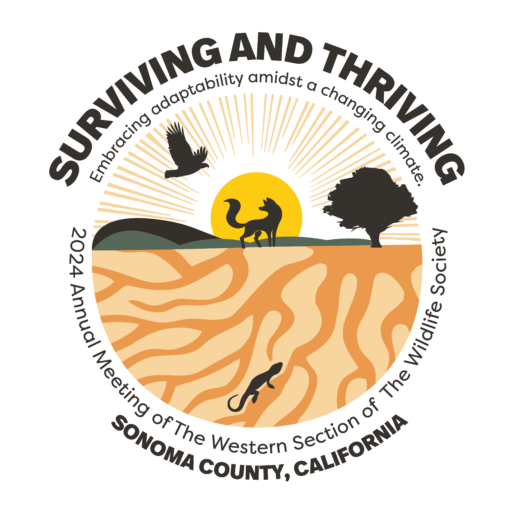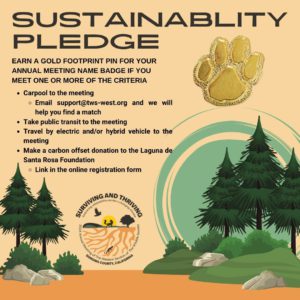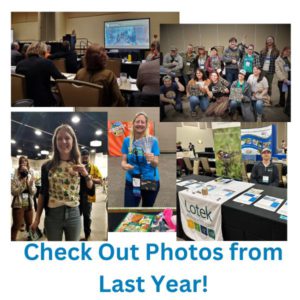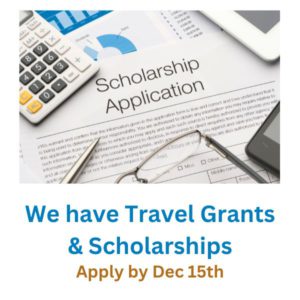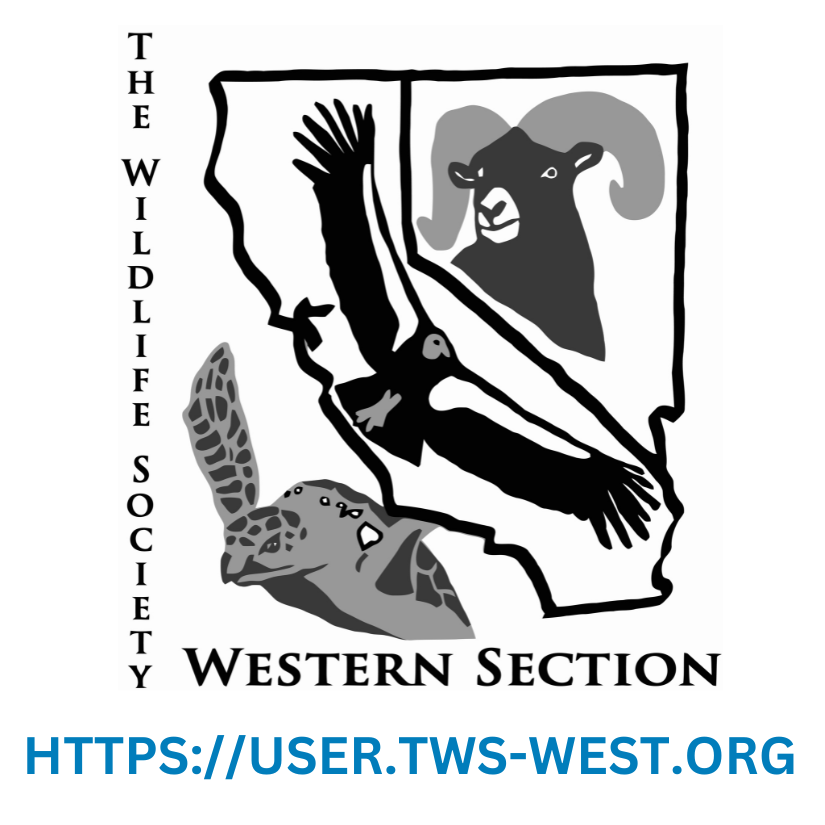Pre-conference events in development include a Snake Symposium, an R Workshop, and several unique Bay Area field trips. If you have suggestions for topics you’d like to see in the future, please email Janine Payne at pdc@tws-west.org.
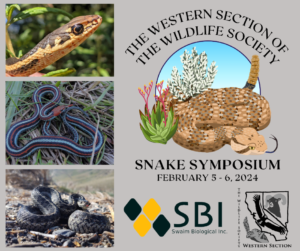 Snake Symposium
Snake Symposium
- Two days! Monday & Tuesday, February 5-6, 2024. Rohnert Park, CA.
- Monday, 1-5:30pm and Tuesday, 8:30am-5:30pm
- Requires separate registration fee. Link to rates
- The Snake Symposium is a stand-alone event so you can register for it on its own.
- Link to Agenda AND Link to Planning Committee Bios
Symposium Description:
The Western Section of the Wildlife Society will be presenting a Snake Symposium at the 2024 Annual Meeting near Santa Rosa. The symposium will be held Monday afternoon, February 5 and all-day Tuesday Feb 6. A broad variety of snake conservation talks will be presented, including research updates on special status species; an overview of Snake Fungal Disease (SFD), its status in the western states, and California’s sampling program; an update on state and federal research permitting requirements; snake conservation genetics; and an overview of global and local snake conservation efforts. Attendees will hear from biologists at state and federal agencies, in academia, from private industry, and from non-governmental agencies. The registration fee will cover the cost of the symposium, lunch on Tuesday, and snake swag.
 Introduction to R Workshop
Introduction to R Workshop
- Tuesday, February 6, 2024 – 8:00am-5:00pm
- Chair: Mitchell Gritts, Nevada Department of Wildlife
- Instructor: Kevin Shoemaker, Ph.D., University of Nevada, Reno
- Requires separate registration fee. Link to rates
- The R Symposium is a stand-alone event so you can register for it on its own.
The main goal of this workshop will be to ensure participants have enough proficiency and confidence with data operations in R to engage in productive, self-directed learning and problem-solving. The workshop is primarily intended for participants with little prior experience with R, but may be useful for others as a refresher. The workshop will focus on R syntax, data management (loading data, writing to file), data visualizations using the popular ‘ggplot2’ package, R packages (loading, getting help), and basic statistical operations.
The workshop consists of a series of modules, each of which covers a particular skill (e.g., reading in data, writing functions). Modules will include a quick introduction, a demonstration in R, and some short challenges for you to work through on your own (or with your neighbors!). All code will be available as scripts that you can download from the web and load up in RStudio.
Sonoma Area Field Trips
The Bay Area Chapter is organizing several unique field trip options for Tuesday, February 6th to highlight the local flora and fauna of the bay area. We hope you’ll join us. Field trips are available to Annual Meeting registered attendees.
(1) Taylor Mountain With Sonoma County Regional Parks
- Tuesday, February 6th: 12:00pm to 2:30pm
- Bring a lunch to eat onsite
- Meet Sheila in the Starbucks parking lot at 1511 Farmers Lane, Santa Rosa at 11:45am (Parking is extremely limited so we’ll carpool to use the minimum number of vehicles.)
- Trip Leader: sheila.murphy@sonoma-county.org
Join Sonoma County Regional Park’s Wildlife Management Technician Sheila Murphy at Taylor Mountain Regional Park to discuss the agency’s (relatively newer) wildlife program including its wildlife camera project, wildlife friendly infrastructure improvements, fencing removal project, monitoring of listed species, collaboration with mountain lion and black bear research, strategies to reduce human-wildlife conflict and its education and outreach efforts.
Attendees should plan for hiking over varied terrain with some steeper uphill and downhill sections. Stops will be made at wildlife camera locations and to review past camera footage. Discussion will also center around mountain lion activity in the park and the agency’s collaboration with local mountain lion researchers. Potential exposure to wet and slippery trails, ticks and poison oak.
(2) CANCELLED DUE TO EXTREME WEATHER Pepperwood Preserve with North Bay Bear Collaborative
- Tuesday, February 6th: 9:00am to 3:00pm
- Bring a lunch to eat onsite
- Self carpool to Pepperwood Preserve at 2130 Pepperwood Preserve Rd, Santa Rosa.
- Trip Leader: shammerich@pepperwoodpreserve.org
Join Wildlife Biologist Steven Hammerich for an introduction to black bear tracking at the majestic Pepperwood Preserve in Sonoma County. Learn about Pepperwood’s land stewardship and ecological research program followed by hiking through diverse habitats where we will identify bear tracks, scat, bear beds, tree markings, and more.
The hike portion of the event will be approximately 3 miles long, with some off-trail and on uneven and steep terrain. Sturdy hiking shoes and long pants are suggested. Please bring a lunch and water and dress in layers appropriate for the weather. Please be advised that the hike will experience poison oak; we ask that you prepare and dress accordingly.
(3) Bodega Marine Lab Docent Tour, UC Davis
- Tuesday, February 6th: 11:00am to 12:30pm
- Bring a lunch to eat onsite
- Carpooling not required but suggested. 2099 Westshore Rd, Bodega Bay.
- Bodega Marine Lab: ucdbml@ucdavis.edu
Perched on the iconic bluffs of Bodega Head, the UC Davis Coastal and Marine Sciences Institute’s Bodega Marine Laboratory, BML, sits at the epicenter of one of only four coastal upwelling regions in the world – areas of extreme biological productivity – that are rich for research discoveries. The Laboratory is also adjacent to a State Marine Protected Area and two National Marine Sanctuaries, yet only 65 miles from San Francisco Bay, one of the most impacted estuaries in the world. BML offers a front-row seat in which to study the real-time impact of commercial, recreational, and residential activity along the coastline and to assess the effectiveness of current and future marine conservation efforts.
Join Bodega Marine Laboratory volunteer docents on an afternnon interpretive tour. Experience a 24-foot-long marine aquarium display, containing many colorful local fishes and invertebrates, and a small kelp forest. Also check out the harbor aquarium, holding residents of our local estuary, Bodega Harbor. Next to that is a round aquarium that displays anemones and other organisms in our nearshore subtidal habitat. Elsewhere around the facility are smaller display aquaria featuring local and, occasionally, unique marine creatures. A tidepool mesocosm display allows visitors to experience the biodiversity and dynamic energy of the northern California coast.
(4) Fairfield Osborn Preserve, Sonoma State University
- Tuesday, February 6th: 12:30-2:00pm
- Easy option, short distance to site, easy walk
- Self carpool to Preserve Lichau Road, Penngrove which is roughly 20 minutes from the Doubletree Hotel.
- Email Docents: ssu.preserves@sonoma.edu
Sonoma State University preserves are outdoor classrooms and living laboratories where students of all ages, backgrounds, and disciplines study human-environment interactions. The 450-acre Fairfield Osborn Preserve lies on the northwest flank of Sonoma Mountain in Sonoma County, California. The preserve ranges in elevation from 1350 to 2300 ft and is characterized by active slumps and landslides, and basalt exposures. Copeland Creek, a perennial drainage at upper elevations, drains into the Laguna de Santa Rosa in the Russian River watershed. Eight plant communities include upland, riparian and freshwater marsh habitats.
Join docents to learn more about the SSU preserve system and research being conducted by students and faculty at Sonoma State. We will walk to Copeland Creek (which may be roaring), and we can share quite a bit about research that’s taking place at the creek, in the oak woodland, and in the marsh. Hike distance is 1 mile with a 200-foot elevation gain.
(5) Amphibians at Mark West Springs Regional Park and Preserve with Dave Cook
- Tuesday, February 6th: 9:00am to 12:00pm
- Self carpool to 3000 Porter Creek Rd, Santa Rosa.
- Trip Leader: salamanderdave@sbcglobal.net
Join us for a guided amphibian field trip to Mark West Creek from 9:00am – noon on February 6, 2024. Mark West Creek Regional Park and Open Space Preserve is a 1,192-acre future Regional Park and is not open to the public. The future park is located within the wooded rolling hills of eastern Sonoma County and supports several terrestrial and aquatic amphibian species. The creek is habitat for three newt species, foothill yellow-legged frog, and California giant salamander. The surrounding woodlands are habitat for yellow-eyed salamander (Ensatina), slender salamander, and arboreal salamander. Dave Cook, local herpetologist, will be the field trip leader and describe the amphibian resources in the area. Participants will hike 2-3 miles along moderate-gradient trails.
The preserve is a 25-min drive from Rohnert Park. Weather is highly variable. Boots and layered clothing are recommended. Attendees will need to be very careful where they step on the hike as this may occur during red-bellied newt migration across the trails.
(6) Wine Tasting & Picnic at Matanzas Creek Winery
- Tuesday, February 6, 2024: 2:00 to 4:00pm
- Carpooling suggested, 15 minutes from Venue. 6097 Bennett Valley Rd, Santa Rosa.
- Trip Leader- Callie Ford: cford@dudek.com
Come have a glass of wine with some snacks at a local (and quite tasty) winery just a few miles from the convention center.
We will be seated in their reserved picnic area and will provide one glass of wine (red or white), snacks and water to each attendee. We’ll also be pouring small tastes of many other delicious Matanzas wines. If you would like to do a more formal wine tasting, you can do so separately between 11am and 3:30pm in their tasting room (starting at $35).Reservations required.*If there is inclement weather, we will be moved inside to one of the winery buildings adjacent to the tasting room.
Matanzas Creek is located in the remote, but breathtakingly beautiful Bennett Valley region of Sonoma County. Since its launch in 1977, the winery has built its reputation on Sauvignon Blanc and Merlot – two varieties that thrive in Sonoma’s temperate climate. Matanzas Creek also produces limited quantities of Chardonnay, Pinot Noir and Bordeaux-style reds. All of the winery’s fruit comes from sustainably-farmed, estate vineyards scattered throughout the mild interior and cool coastal AVAs of the county.
In addition to its wines, Matanzas Creek is also famous for their spectacular lavender gardens. The unique character and beauty of Matanzas Creek’s winery, vineyards, lavender field and gardens have earned the Estate worldwide recognition as a premier California wine country destination. We invite you to stroll the grounds, play a game of bocce or enjoy our picnic areas. https://www.matanzascreek.com/
(7) Gives Back Volunteer Restoration Event
- Tuesday, February 6th, 1:00pm to 3:30pm.
- FREE, Max 50 people
- Carpooling suggested, meet at Doubletree Lobby at 12:30pm to carpool. 900 Sanford Rd (at Occidental Rd.), Santa Rosa, CA. Meet in front of Heron Hall, barn-like building with red doors. No pets, please.
- Wear clothes you don’t mind getting dirty, and waterproof shoes or boots. Bring gardening gloves and a water bottle.
- Heavy rain cancels, we will update this website and email attendees if we need to cancel.
- Trip Leader: Brooke Langle brooke.langle@swca.com ;
After a brief overview about the Laguna de Santa Rosa and the work of the Laguna Foundation, we will split into 3 groups: potting plants in our native plant nursery, planting sedge for riparian restoration on a nearby creek, and weeding in our demonstration garden. Trail bars and fruit will be provided by Laguna Foundation.
Please note, heavy rain cancels, so we will check the forecast the day before and be sure to notify you in advance if we are expecting heavy rain. Otherwise, we will work in intermittent showers. We greatly appreciate your volunteer support and look forward to seeing you soon!
About the Laguna: The Laguna de Santa Rosa is the largest freshwater wetlands complex on the northern California coast. In a state known for extraordinary biological diversity, it is located in the second-most biologically rich county, Sonoma, and is a major contributor to the County’s biological diversity. The Laguna’s 22-mile channel forms the largest tributary to the Russian River, draining a 254-square-mile watershed which encompasses nearly the entire Santa Rosa Plain. This includes all or part of the communities of Windsor, Santa Rosa, Rohnert Park, Cotati, Forestville, and Sebastopol.
As the receiving basin of a watershed where most of the county’s human population lives, the Laguna is a landscape feature of critical importance to Sonoma County’s water quality and flood control. It provides an important overflow area for the Russian River during periods of heavy winter rain, serving as a natural holding basin which captures and slows floodwaters, easing their impact on lower Russian River communities.
But the Laguna is far more than its main channel. It is a unique ecological system covering more than 30,000 acres; a mosaic of creeks, open water, perennial marshes, seasonal wetlands, riparian forests, oak woodland and grassland. It is home to hundreds of species of birds from bald eagles to hummingbirds; mammals such as mink, badger, bobcat and river otter; and numerous fish and amphibians, including several rare and endangered species.
The wetlands of the Laguna are an important stopover for thousands of birds that migrate along the Pacific flyway, as well as a permanent home to myriad species. Its riparian forest — interface between land and flowing surface water — is a layered habitat of trees, shrubs and undergrowth. It provides food, shelter, and a travel corridor for wildlife, filters nutrients and pollutants from agricultural and urban runoff, and shades and cools the water for fish and other aquatic organisms. http://www.lagunafoundation.org/5
